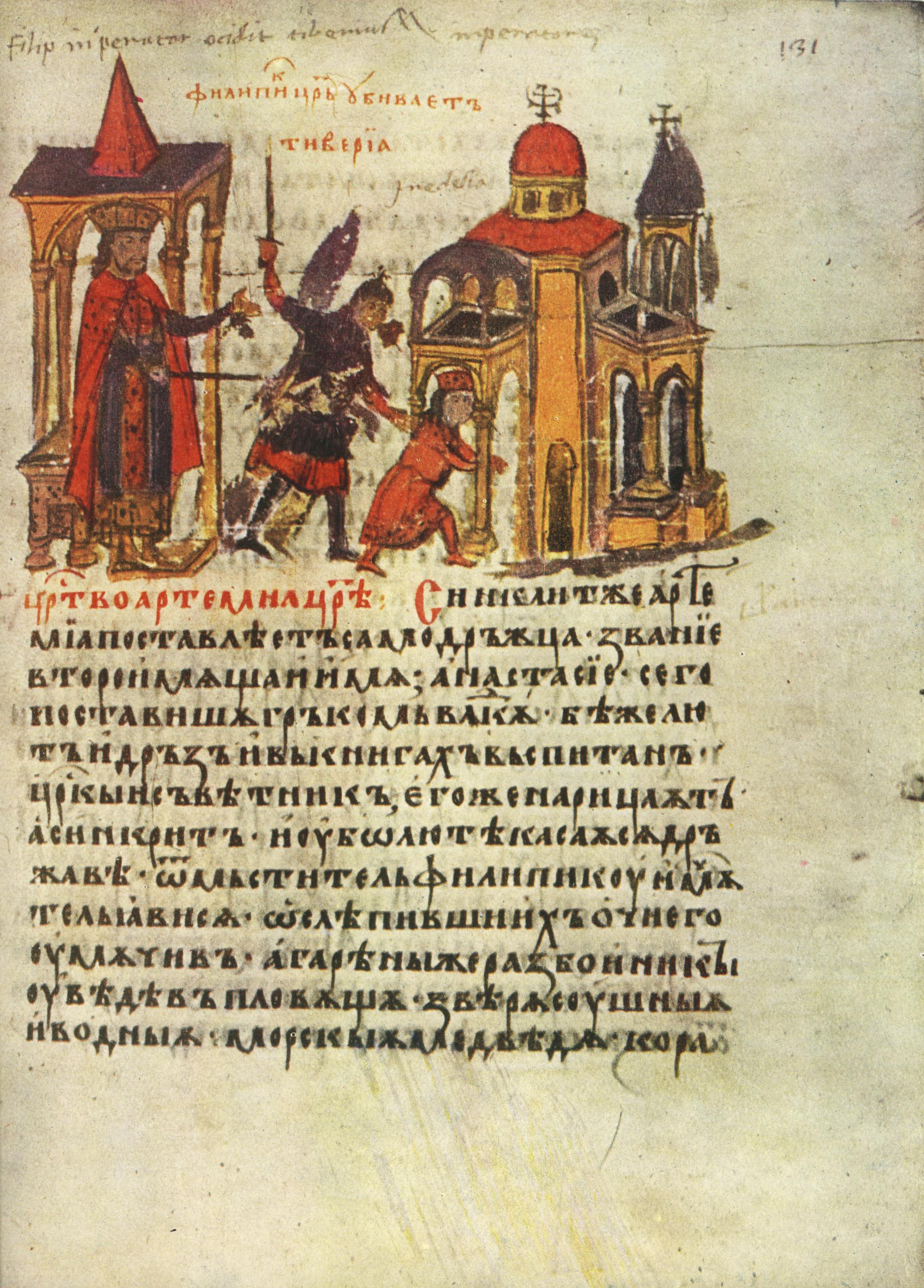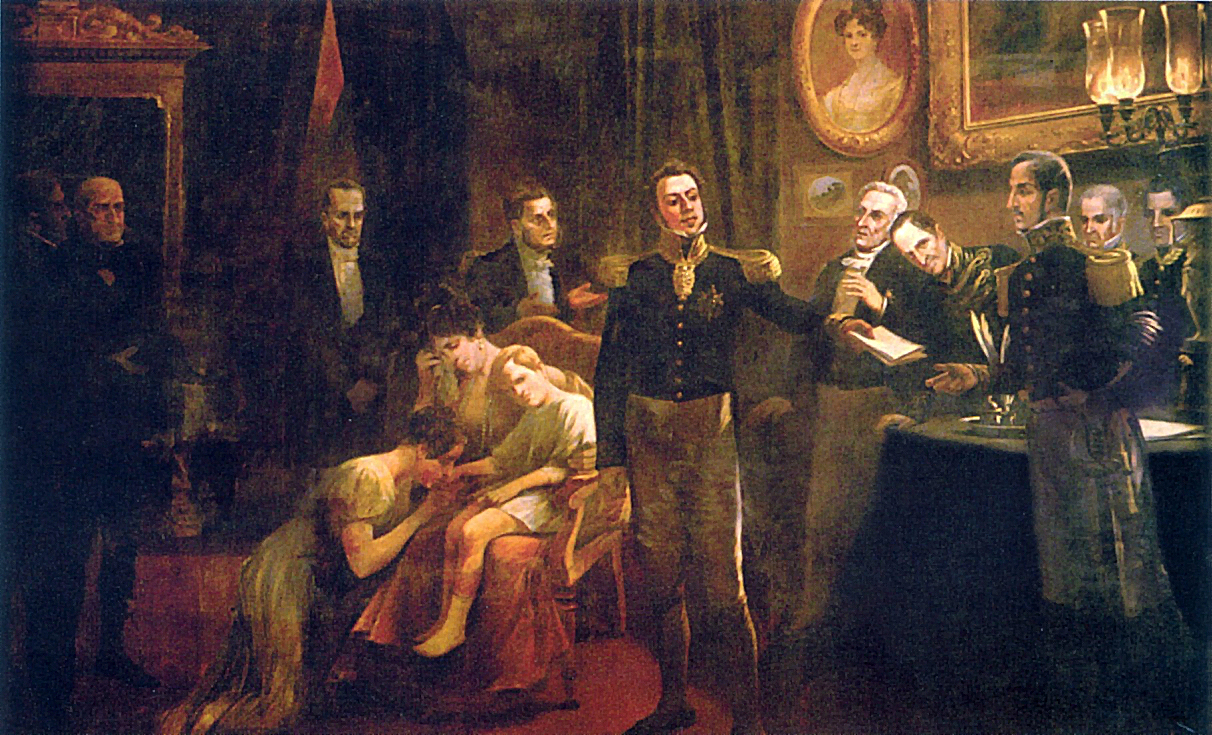|
Theodosius III
Theodosius III () was Byzantine emperor from to 25 March 717. Before rising to power and seizing the throne of the Byzantine Empire, he was a tax collector in Adramyttium. In 715, the Byzantine navy and the troops of the Opsician Theme, one of the Byzantine provinces, revolted against Emperor Anastasius II (), acclaiming the reluctant Theodosius as emperor. Theodosius led his troops to Chrysopolis and then Constantinople, the capital, seizing the city in November 715. Anastasius did not surrender until several months later, accepting exile in a monastery in return for safety. Many themes viewed Theodosius to be a puppet of the troops of the Opsician Theme, and his legitimacy was denied by the Anatolics and the Armeniacs under their respective (generals) Leo the Isaurian and Artabasdos. Leo declared himself emperor in the summer of 716 and allied himself with the Umayyad Caliphate, the Islamic empire; Theodosius sought aid from the Bulgarians under Khan Tervel (), sett ... [...More Info...] [...Related Items...] OR: [Wikipedia] [Google] [Baidu] |
Solidus (coin)
The ''solidus'' (Latin 'solid'; : ''solidi'') or ''nomisma'' () was a highly pure gold coin issued in the Later Roman Empire and Byzantine Empire. It was introduced in the early 4th century, replacing the aureus, and its weight of about 4.45 grams remained relatively constant for seven centuries. In the Byzantine Empire, the solidus or nomisma remained a highly pure gold coin until the 11th century, when several Byzantine emperors began to strike the coin with debasement, less and less gold. The nomisma was finally abolished by Alexios I Komnenos in 1092, who replaced it with the hyperpyron, which also came to be known as a "bezant". The Byzantine solidus also inspired the zolotnik in the Kievan Rus' and the originally slightly less pure gold dinar first issued by the Umayyad Caliphate beginning in 697. In Western Europe, the solidus was the main gold coin of commerce from late Roman times to the Early Middle Ages. In Late Antiquity and the Middle Ages, the solidus also ... [...More Info...] [...Related Items...] OR: [Wikipedia] [Google] [Baidu] |
Strategos
''Strategos'' (), also known by its Linguistic Latinisation, Latinized form ''strategus'', is a Greek language, Greek term to mean 'military General officer, general'. In the Hellenistic world and in the Byzantine Empire, the term was also used to describe a military governor. In the modern Hellenic Army, it is the highest officer rank. Etymology ''Strategos'' is a compound of two Greek words: ''stratos'' and ''agos''. ''Stratos'' (στρατός) means 'army', literally 'that which is spread out', coming from the proto-Indo-European root *stere-, 'to spread'. ''Agos'' (ἀγός) means 'leader', from ''agein'' (ἄγειν), 'to lead', from the pelasgic root *ag-, 'to drive, draw out or forth, move'. Classical Greece Athens In its most famous attestation, in Classical Athens, the office of ''strategos'' existed already in the 6th century BC, but it was only with the reforms of Cleisthenes in 501 BC that it assumed its most recognizable form: Cleisthenes instituted a boa ... [...More Info...] [...Related Items...] OR: [Wikipedia] [Google] [Baidu] |
Justinian II
Justinian II (; ; 668/69 – 4 November 711), nicknamed "the Slit-Nosed" (), was the last Byzantine emperor of the Heraclian dynasty, reigning from 685 to 695 and again from 705 to 711. Like his namesake, Justinian I, Justinian II was an ambitious and passionate ruler who was keen to restore the Roman Empire to its former glories. However, he responded brutally to any opposition to his will and lacked the finesse of his father, Constantine IV. Consequently, he generated enormous opposition to his reign, resulting in his deposition in 695 in a popular uprising. He only returned to the throne in 705 with the help of a Bulgar and Slav army. His second reign was even more despotic than the first, and in 711 he was killed by mutinous soldiers. First reign Justinian II was the eldest son of Emperor Constantine IV and Anastasia. His father appointed him as his heir sometime after October 682, upon the deposition of his uncles Heraclius and Tiberius. In 685, at the age of sixteen, J ... [...More Info...] [...Related Items...] OR: [Wikipedia] [Google] [Baidu] |
Siege Of Constantinople (674–678)
Constantinople was besieged by the Arabs in 674–678, in what was the first culmination of the Umayyad Caliphate's expansionist strategy against the Byzantine Empire. Caliph Mu'awiya I, who had emerged in 661 as the ruler of the Muslim Arab empire following a First Fitna, civil war, renewed Arab–Byzantine wars, aggressive warfare against Byzantium after a lapse of some years and hoped to deliver a lethal blow by capturing the Byzantine capital of Constantinople. As reported by the Byzantine chronicler Theophanes the Confessor, the Arab attack was methodical: in 672–673 Arab fleets secured bases along the coasts of Asia Minor and then installed a loose blockade around Constantinople. They used the peninsula of Cyzicus near the city as a base to spend the winter and returned every spring to launch attacks against the Walls of Constantinople, city's fortifications. Finally the Byzantines, under Emperor Constantine IV, destroyed the Arab navy using a new invention, the liqui ... [...More Info...] [...Related Items...] OR: [Wikipedia] [Google] [Baidu] |
Abdicate
Abdication is the act of formally relinquishing monarchical authority. Abdications have played various roles in the succession procedures of monarchies. While some cultures have viewed abdication as an extreme abandonment of duty, in other societies (such as pre-Meiji Restoration Japan), abdication was a regular event and helped maintain stability during political succession. Historically, abdications have occurred both by force (where the regnant was '' dethroned'', thus forced to abdicate on pain of death or other severe consequences) and voluntarily. Some rulers are deemed to have abdicated ''in absentia'', vacating the physical throne and thus their position of power, although these judgements were generally pronounced by successors with vested interests in seeing the throne abdicated, and often without or despite the direct input of the abdicating monarch. Recently, due to the largely ceremonial nature of the regnant in many constitutional monarchies, many monarchs have ... [...More Info...] [...Related Items...] OR: [Wikipedia] [Google] [Baidu] |
Germanus I Of Constantinople
Germanus I of Constantinople (, Greek: Γερμανός; 634 – 742) was the Ecumenical Patriarch of Constantinople from 715 to 730. He is regarded as a saint by both the Orthodox and Catholic Churches, with a feast day of 12 May. He had been ecumenically preceded by Patriarch John VI of Constantinople, and was succeeded in Orthodox Rite by Patriarch Anastasius of Constantinople. Life According to Theophanes the Confessor, Germanus I was a son of a patrician named Justinian, who was executed in 668. Justinian was reportedly involved in the murder of Constans II and usurpation of the throne by Mizizios. Emperor Constantine IV, son of Constans II, defeated his rival and punished the supporters of Mizizios. Germanus I survived the persecutions but was made a eunuch by the victors. Germanus I was sent to a monastery but resurfaced as the Bishop of Cyzicus. He took part in the Council of Constantinople in 712, a gathering which issued decisions favoring Monothelitism, ther ... [...More Info...] [...Related Items...] OR: [Wikipedia] [Google] [Baidu] |
Nicomedia
Nicomedia (; , ''Nikomedeia''; modern İzmit) was an ancient Greece, ancient Greek city located in what is now Turkey. In 286, Nicomedia became the eastern and most senior capital city of the Roman Empire (chosen by the emperor Diocletian who ruled in the east), a status which the city maintained during the Tetrarchy system (293–324). The Tetrarchy ended with the Battle of Chrysopolis (Üsküdar#Chrysopolis, Üsküdar) in 324, when Constantine the Great, Constantine defeated Licinius and became the sole emperor. In 330 Constantine chose for himself the nearby Byzantium (which was renamed Constantinople, modern Istanbul) as the new capital of the Roman Empire. The city was incorporated into the Ottoman Empire with the victory of Sultan Orhan Gazi against the Byzantine Empire. The Byzantines managed to retake it in the aftermath of the Battle of Ankara, but it fell definitively to the Ottomans in 1419. History It was founded in 712–711 BC as a Megarian colony and was original ... [...More Info...] [...Related Items...] OR: [Wikipedia] [Google] [Baidu] |
Zagore (region)
Zagore ( ), also Zagorie (), Zagora (), or Zagoriya (), was a vaguely defined medieval region in what is now Bulgaria. Its name is of Slavic origin and means "beyond .e. south ofthe alkanmountains". The region was first mentioned as Ζαγόρια in Greek (in an Old Bulgarian translation it was rendered as Загорїа) when it was ceded to the First Bulgarian Empire by the Byzantine Empire during the rule of Tervel of Bulgaria in the very beginning of the 8th century ( Byzantine–Bulgarian Treaty of 716). From the context, Zagore can be defined as a region in northeastern Thrace. During the Second Bulgarian Empire, the region was also mentioned in Tsar Ivan Asen II of Bulgaria's post-1230 Dubrovnik Charter, which allowed Ragusan merchants to trade in the Bulgarian lands, among which "the whole Zagore" (пѡ всемѹ Загѡриѹ). A 14th-century Venetian documents refer to Zagora as a synonym for Bulgaria (e.g. ''partes del Zagora, subditas Dobrotice'' in a doc ... [...More Info...] [...Related Items...] OR: [Wikipedia] [Google] [Baidu] |
Thrace
Thrace (, ; ; ; ) is a geographical and historical region in Southeast Europe roughly corresponding to the province of Thrace in the Roman Empire. Bounded by the Balkan Mountains to the north, the Aegean Sea to the south, and the Black Sea to the east, it comprises present-day southeastern Bulgaria (Northern Thrace), northeastern Greece (Western Thrace), and the European part of Turkey (East Thrace). Lands also inhabited by ancient Thracians extended in the north to modern-day Northern Bulgaria and Romania and to the west into Macedonia (region), Macedonia. Etymology The word ''Thrace'', from ancient Greek ''Thrake'' (Θρᾴκη), referred originally to the Thracians (ancient Greek ''Thrakes'' Θρᾷκες), an ancient people inhabiting Southeast Europe. The name ''Europe'' (ancient Greek Εὐρώπη), also at first referred to this region, before that term expanded to include its Europe, modern sense. It has been suggested that the name ''Thrace'' derives from the na ... [...More Info...] [...Related Items...] OR: [Wikipedia] [Google] [Baidu] |
Tervel
Caesar Tervel (), also called Tarvel, Terval, or Terbelis in Byzantine sources, was the ruler Caesar of Bulgaria during the First Bulgarian Empire at the beginning of the 8th century. In 705 Emperor Justinian II named him caesar, the first foreigner to receive this title.Хан Тервел – тема за кандидат студенти He was raised a pagan like his grandfather Khan Kubrat, „История славянобългарска“, св.Паисий Хиле ... [...More Info...] [...Related Items...] OR: [Wikipedia] [Google] [Baidu] |







